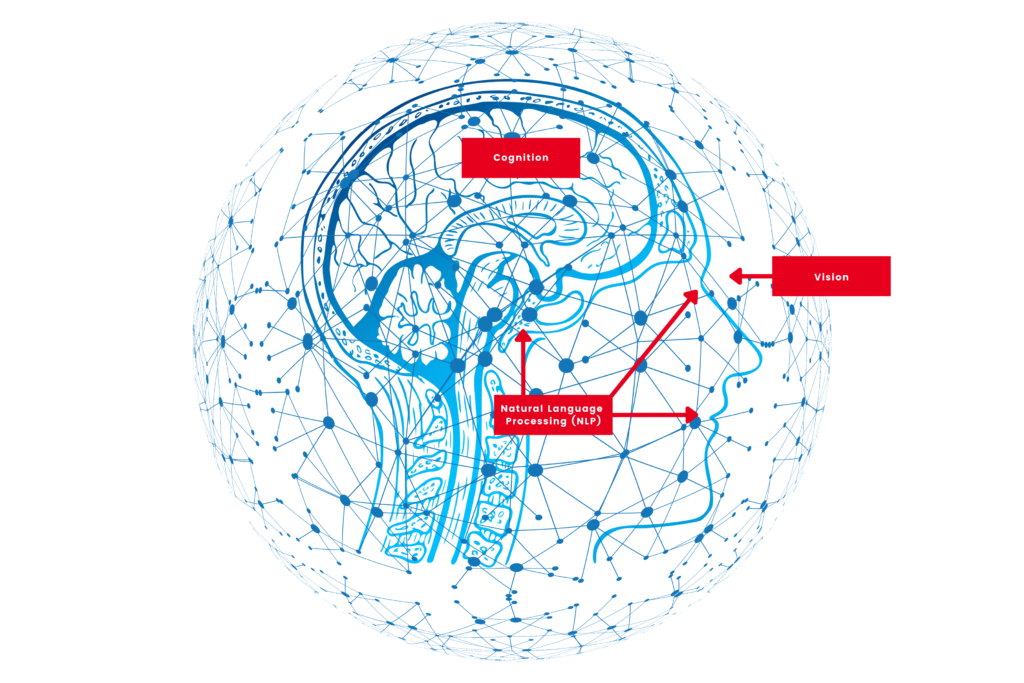06 Dec AI for Business: Deconstructing AI (Part 1)
In our last installment, we presented a high-level overview of the AI domain. Today we’ll dive deeper to better understand AI’s capabilities.
SO JUST WHAT IS AI?
Read the AI for Business series:
Much of the marketing hype surrounding AI would lead you to believe that it is monolithic and mysterious. While marketers try to leverage this mystique to their advantage, it couldn’t be further from the truth.
AI isn’t just one thing. It’s an umbrella term, a category of technologies and techniques[1] that encompasses a wide array of capabilities and that attempts to address a wide range of use cases. For example, while predicting customer churn, facial recognition, language translation, and robotic process automation are all legitimately “AI,” they represent four very different capabilities. The remainder of this installment will attempt to describe this landscape from a human (and business) perspective.
AI (DECONSTRUCTED) FOR HUMANS
Acronyms are wonderful devices – shorthand that helps us communicate more efficiently and effectively. In this case though, the acronym “AI” tends to obscure its true character. The term artificial intelligence is well chosen as its capabilities are intended to mimic those of human beings, particularly intelligence, the capability that makes us… human.
My first attempt to write this installment used a functional taxonomy to describe the branches and capabilities of the AI domain. While a taxonomy is a useful reference (and I’ve included it at the end of this installment for my fellow wonks), a more direct approach is to dive right in and look at AI as it relates to human behavior.
Generally speaking, AI can be categorized into four buckets. These core capabilities – cognition, language, vision, and automation are designed to mimic human functionality and are what make AI unique, powerful, and increasingly indispensable.

Cognition refers to the ability for machines to “learn” and “think” like humans do, and autonomously improve this learning over time, by ingesting information in the form of observations and real-world interactions. This is similar to the way an infant learns to think and react, through repeated observation and imitation, improving its understanding over time. Using our AI/human analogy, cognition is the “brain” of AI.
Machine learning (ML) is the term commonly used to describe the family of AI techniques that “perform cognition.” As you might imagine, (machine) learning is fundamental to becoming (artificially) intelligent. As we will see, many (perhaps most) AI solutions include some form of ML. In my opinion, without the ability to learn, AI doesn’t exist.
AI’s language capability, commonly referred to as natural language processing (NLP) focuses on hearing, speaking, reading, and writing – the ability for machines to understand oral and/or written language, including human speech, the content of documents, and the contextual nuances of the language within them. Using our AI-human analogy, AI’s language capability forms its “ears” and “mouth.”
The basis for AI’s vision processing capability is self-explanatory as it deals with AI’s ability to “see” and act on what it detects. In this sense, AI’s vision capability acts as its “eyes,” but this analogy comes with a caveat. Human eyes act as sensors to see and transmit real-time images to the brain for processing. AI can provide the same functionality using cameras, but its vision capabilities go far beyond this. AI can use radar, lasers, x-rays, and other technologies to “see” beyond the human visual spectrum. In addition, it isn’t limited to real-time vision, but has the ability to interpret and process images and video captured at any time.
In one sense, humans can be thought of as automatons who happen to breathe. Our final category focuses on AI’s approximation of this type of functionality, including both process and physically-oriented automation. Businesses tend to be process-oriented and automation of repetitive processes has been an early success story for AI. Physical automation, beginning with my beloved Roomba, has the potential for AI to (again) transform business in ways that are somewhat difficult to perceive. Autonomous vehicles are the next logical step, but certainly not the final chapter in this cogno-technological[2] revolution.
IT’S A TRAP!
In addition to being an iconic Star Wars line, this warning also applies to AI. While categorizing AI’s capabilities is a convenient tool for human understanding, it’s easy to oversimplify its utility. AI categories are frequently used in combination to solve larger, more complex AI use cases. As an example, cognition (machine learning) is combined with vision and automation techniques to enable autonomous vehicle navigation (e.g., “learning” that a yellow light indicates that a red light will quickly follow). We should be cautious when attempting to pigeonhole business problems into strict AI categories, as a combination of these is frequently the most effective approach to solving them.
WHAT’S NEXT?
The next couple of installments will examine each of our four AI categories in more depth, specifically looking at the AI techniques that comprise each category and some industry use cases to make them real. We’ll start with (probably) the most important to business leaders – cognition.
APPENDIX: A FUNCTIONAL TAXONOMY
As we mentioned earlier in this installment, the term AI covers a lot of territory. While no one reference can address all of the intricacies and overlapping areas of AI, one approach that resonates at Access Sciences is a functional taxonomy.
Functional refers to how we categorize AI into its broadest capabilities. We then organize AI techniques that support these capabilities into branches of a taxonomy. At first, this description might not make sense, but a quick examination of our taxonomy should make things clear. To illustrate this, in the diagram below, one AI capability is cognition and the family of AI techniques that support it include prediction, classification, clustering, and recognition.

[1] As a handy reference, Wikipedia has an excellent and exhaustive glossary of AI terminology and concepts.
[2] Ok, I cheated and created this term as a place holder while attempting to succinctly describe the potential for “thinking” machines to transform business and society. After rereading it a few times, I think I’ll keep it!
FOR MORE INFORMATION
Stay tuned for Glen’s next blog in the AI for Business series to learn more about Cognition.



